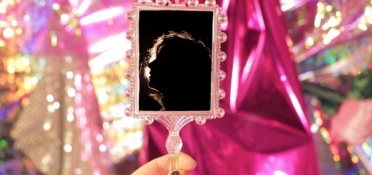He is a Proud Boy. Polite and low-key, his midwestern manners would please anyone’s mother. He works with his dad around their modest yellow house on Second Street, fixing up a newly purchased home in an old-fashioned, close-knit neighborhood—the kind of place where residents check in on one another. He seems like a normal kid.
He is handsome, cute, but quiet. Shy. His tattoos are innocuous pop-culture references: A slice of cherry pie adorns one arm, a homage to the TV show Twin Peaks. He is a big Seinfeld fan. He likes to gamble, listens to country music. He is not a star.
This is a nice, handsome-looking boy, like an articulate and well-dressed former football player with prom-king good looks. His face is narrow and punctuated with sharply peaked eyebrows, like a pair of air quotes. He looks like any 20-something or 30-year-old with his short-on-the-sides, long-on-the-top haircut. He is dapper, a buttoned-down millennial, in his dark suits and ties, or he is decked out in white polo shirts and khakis, or he wears neat jeans, button-down shirts, cargo shorts. He wears jeans and striped pullovers that look like they could have come from the sale rack at a local Gap. He wears clothes that are acceptable and appropriate, clothes that make him look like he belongs.
He was a former Boy Scout, played varsity football and baseball, and hung out with the popular crowd. Sometimes, he could be like those mischievous boys who want to have some fun, but he was never in the principal’s office for trouble. He attended solidly middle-class, racially integrated schools, grew up with black friends, and came from a respected family. He is a tough person but has a very big heart.
Many afternoons, he will sit silently on the curb in front of his roomy yard and, when he is tired of it, move to a different curb. He helps neighbors with their yard work.
When something bothers him, he likes to go for a hike.
He does not want for anything.
_________________________________
¹ As told through the compilation and arrangement of quotes taken from various news articles on neo-Nazis, white supremacists, white nationalists, the KKK, Dylann Roof, Darren Wilson, and Mark Conditt. This material has been lightly edited for narrative clarity.
Comments of Gwendolyn Chisholm, in reference to white supremacists who murdered James Byrd, Jr. Quoted in Alison Kinney, “How the Klan Got Its Hood,” New Republic, 8 January 2016.
Congressional testimony given in 1871 by former Georgia representative John H. Christy in reference to the KKK. Quoted in Alison Kinney, “How the Klan Got Its Hood,” New Republic, 8 January 2016.
Fausset, Richard. “A Voice of Hate in America’s Heartland.” New York Times, 25 November 2017.
Ghansah, Rachel Kaadzi. “A Most American Terrorist: The Making of Dylann Roof.” GQ, 21 August 2017.
Givhan, Robin. “Neo-Nazis Are Using Fashion in an Attempt to Normalize. The Fashion Industry Needs to Speak Up.” Washington Post, 22 August 2017.
Halpern, Jake. “The Cop.” New Yorker, 10 and 17 August 2015.
Harkinson, Josh. “Meet the White Nationalist Trying to Ride the Trump Train to Lasting Power.” Mother Jones, 27 October 2016.
Mascaro, Lisa. “White Nationalists Dress Up and Come to Washington in Hopes of Influencing Trump.” Los Angeles Times, 19 November 2016.
Moravec, Eva Ruth, Tim Craig, Scott Wilson, and Mark Berman. “Austin Bomber Was Frustrated with His Life, Authorities Say.” Washington Post, 21 March 2018.
Robles, Frances, and Nikita Stewart. “Dylann Roof’s Past Reveals Trouble at Home and School.” New York Times, 16 July 2015.



